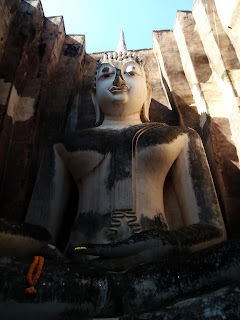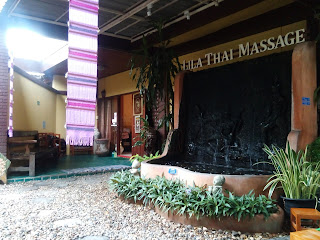{SCROLL DOWN FOR ENGLISH}
C'è un luogo dove personalmente ho sentito tutta la magia e il fascino ancestrale di questa terra, un luogo che ha avuto il potere di affascinarmi nel vero senso del termine. Sto parlando di Sukhothai e del suo parco archeologico. Un posto magico a metà strada tra Chiang Mai e Bangkok che rimane periferico rispetto agli itinerari principali ma merita davvero una deviazione.
Il parco storico di Sukhothai è inserito nell'elenco UNESCO come patrimonio mondiale dal 1991. La città è stata la prima capitale del regno del Siam tra XIII e XIV secolo, i suoi monumenti rappresentano le origini dell'architettura thailandese. Sotto il patrocinio reale, il buddismo fiorì e furono costruiti molti monasteri in mattoni ricoperti di stucco, che mostrano la bellezza idealizzata e le caratteristiche sovrumane (mahapurisalakkhana) del Buddha e dei suoi insegnamenti.
È dai resti di questi monumenti religiosi che oggi conosciamo e apprezziamo meglio le conquiste del popolo della città storica di Sukhothai e delle città associate Si Satchanalai and Kamphaeng Phet.
È dai resti di questi monumenti religiosi che oggi conosciamo e apprezziamo meglio le conquiste del popolo della città storica di Sukhothai e delle città associate Si Satchanalai and Kamphaeng Phet.
Il parco conserva la cerchia di mura rimasta della cittadella reale che forma un rettangolo lungo 1810 metri circa sull'asse est-ovest e 1400 metri su quello nord-sud. Al centro di ogni lato si trova una porta di accesso. All'interno ci sono le rovine del palazzo reale e di 21 templi, il più grande dei quali è il Wat Mahathat, che era la cappella reale. Le mura, costruite in mattoni, sono circondate da un fossato e all'esterno vi sono altri templi e palazzi che fanno parte del parco.
Gli edifici furono costruiti nel classico stile di Sukhothai, che subì influenze delle preesistenti architetture khmer, cingalesi e mon. A sua volta lo stile di Sukhothai avrebbe influenzato gran parte della successiva architettura siamese. Nelle statue dei Buddha, la forma allungata del naso e la protuberanza a forma di fiamma posta sulla sommità del capo, che rappresenta lo splendore dell'energia spirituale, sono caratteristiche mutuate dalla tradizione cingalese.
La doppia linea attorno alla bocca deriva invece dall'arte khmer.
La doppia linea attorno alla bocca deriva invece dall'arte khmer.
Di rilievo le antiche opere idrauliche presenti nella città murata. Il fossato che circonda le mura, scavato anche per proteggersi dagli attacchi nemici, i 175 stagni ed i 147 pozzi erano alimentati con le acque di un vicino canale ed usati come riserve d'acqua. Il sistema di trasmissione delle acque è rappresentato da un antico acquedotto, le cui tubazioni sono fatte in terracotta smaltata.
Il parco è gestito dal Dipartimento delle Belle Arti della Thailandia con la supervisione dell'UNESCO.
Il consiglio è quello di visitare il parco noleggiando una bicicletta potrete così circolare godendovi il silenzio e la meraviglia dei vari templi con calma. Il parco è tenuto benissimo con molti alberi e zone d'ombra. Non si può che restare affascinati da tanta bellezza. E' preferibile fermarsi almeno una notte in uno degli alberghi vicini al parco in modo di poter godere della sua visione fino al tramonto dove i resti si colorano di un arancione intenso regalondovi delle emozioni aggiuntive.
Io ho visitato Sukhotai quattro anni fa, partendo da Chiang Mai con un bus di linea intorno alle otto del mattino, arrivando nel primo pomeriggio. E già nell'immediato ho continuato a fare riferimento alla sindrome di Stendhal per la sensazione di essere sopraffatti dalla meraviglia per tanta bellezza. Qui di seguito vi posto il link all'album di foto nella speranza che vi aiutino a capire cosa intendo: Sukhothai
Io ho visitato Sukhotai quattro anni fa, partendo da Chiang Mai con un bus di linea intorno alle otto del mattino, arrivando nel primo pomeriggio. E già nell'immediato ho continuato a fare riferimento alla sindrome di Stendhal per la sensazione di essere sopraffatti dalla meraviglia per tanta bellezza. Qui di seguito vi posto il link all'album di foto nella speranza che vi aiutino a capire cosa intendo: Sukhothai
ENGLISH VERSION]
There is a place where I personally felt all the magic and ancestral charm of this land, a place that had the power to fascinate me in the true sense of the word. I am talking about Sukhothai and its archaeological park. A magical place halfway between Chiang Mai and Bangkok that remains on the periphery of the main itineraries but really deserves a diversion.
The Sukhothai Historical Park has been a UNESCO World Heritage Site since 1991. The city was the first capital of the kingdom of Siam between the 13th and 14th centuries and its monuments represent the origins of Thai architecture. Under royal patronage, Buddhism flourished and many brick monasteries covered in stucco were built, displaying the idealised beauty and superhuman characteristics (mahapurisalakkhana) of the Buddha and his teachings.
It is from the remains of these religious monuments that we now know and appreciate better the achievements of the people of the historic city of Sukhothai and the associated cities of Si Satchanalai and Kamphaeng Phet.
The park preserves the remaining circle of walls of the royal citadel which forms a rectangle about 1810 metres long on the east-west axis and 1400 metres on the north-south axis. In the centre of each side is a gateway. Inside are the ruins of the royal palace and 21 temples, the largest of which is Wat Mahathat, which was the royal chapel. The brick walls are surrounded by a moat and outside are other temples and palaces that are part of the park.
The buildings were constructed in the classic Sukhothai style, which was influenced by pre-existing Khmer, Sinhalese and Mon architecture. In turn, the Sukhothai style would influence much of the later Siamese architecture. In the Buddha statues, the elongated shape of the nose and the flame-shaped protuberance on the top of the head, representing the radiance of spiritual energy, are features borrowed from the Sinhalese tradition.
The double line around the mouth, on the other hand, comes from Khmer art.
The ancient hydraulic works in the walled city are remarkable. The moat surrounding the walls, also dug to protect against enemy attacks, the 175 ponds and 147 wells were fed with water from a nearby canal and used as water reserves. The water transmission system is an ancient aqueduct, whose pipes are made of glazed earthenware.
The park is managed by the Department of Fine Arts of Thailand under the supervision of UNESCO.
The advice is to visit the park by renting a bicycle so you can get around and enjoy the silence and wonder of the various temples at your leisure. The park is very well maintained with many trees and shady areas. One cannot be anything other than fascinated by such beauty. It is preferable to stay at least one night in one of the hotels near the park so you can enjoy its vision until sunset when the remains turn an intense orange giving you additional emotions.
I visited Sukhotai four years ago, leaving Chiang Mai on a regular bus around eight in the morning, arriving in the early afternoon. And right from the start I kept referring to Stendhal's syndrome for the feeling of being overwhelmed with wonder at so much beauty. Below is the link to the photo album in the hope that it will help you understand what I mean: Sukhothai



























































